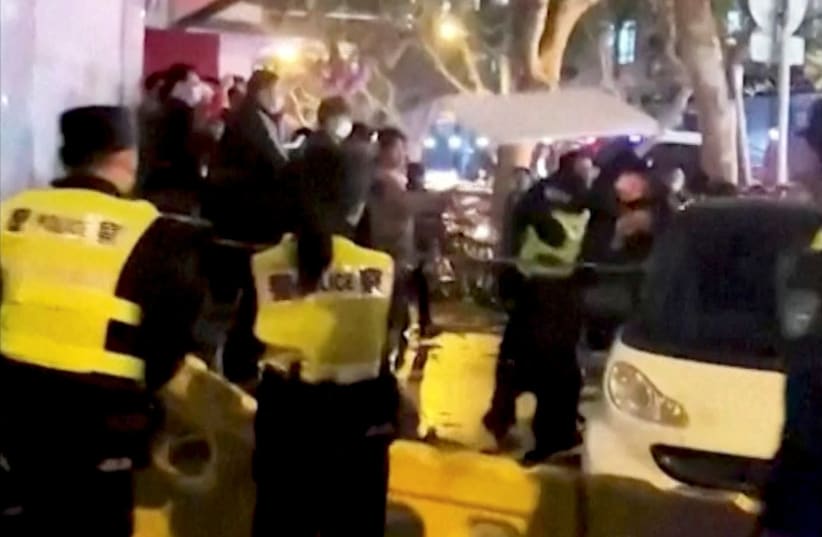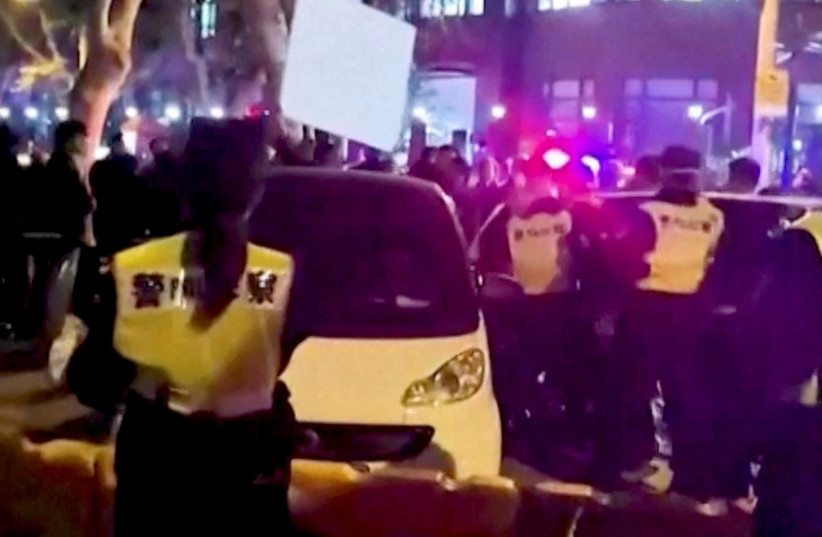A month ago, China’s leadership appeared invincible. President Xi Jinping presided over a Communist Party Congress that appeared to cement his rule and reduce the influence of former leaders and any critics who might be within the party itself. Former Chinese president Hu Jintao was suddenly – and embarrassingly – escorted out of a closing ceremony during the event.
Now, reports say China is facing unprecedented protests in Beijing and Shanghai, following other demonstrations in Urumqi in the northwest, in Chengdu in the southwest and in Xian and Wuhan. There were also protests at an iPhone production facility.
Protests have been ongoing in Iran for the past two months. Iran and China are partners that both seek to upend the West and the US-led rules-based international order. This isn’t a secret. Iran and China have both openly sought to challenge the US and want a world that is multipolar – more regional powers and less concentrated American power.
Russia also is part of this bloc of countries, along with Turkey. But in those countries, there have not been any protests.
COVID-19 outbreak in China
China’s internal system and power goals in the world have been contrasted with the US role, which Beijing has presented as chaotic, as opposed to China’s. This only increased with the outbreak of coronavirus in 2020, with China appearing to handle its outbreak “better” than the West.
China boasted that its lockdowns worked. Three years later, the nearly continuous lockdown policy is igniting protests.
Beijing has sought to isolate itself over the last few years. In contrast to the period between 1990 and 2020, when China slowly sought to peddle influence and debt to other countries, it now appears more cut off from the world. This affected supply chains and the West’s dependence on China. Many countries are now looking into moving manufacturing and reliance out of China.
In the first two years of the pandemic, many countries believed China’s boasts about its successes. In June 2021, China said it had administered more than one billion vaccine doses. By September 2021, when the US was still in the midst of vaccine disputes, reports by The New York Times and Bloomberg claimed China had “fully vaccinated” more than one billion people. By November 2021, China said it had completely vaccinated 75% of its population while providing one billion vaccines to Africa. By May 2022, China claimed it had provided some 2.2 billion vaccines to 120 countries. China was winning the vaccine race.
It now appears that some of the stories coming out of China were not as rosy as they first appeared. Reports in February by a joint WHO-China study claimed that China had reined in COVID-19, but reports in May said China had not vaccinated many of its elderly.
It turned out that in June 2022, some 90 million Chinese citizens over the age of 60 were not vaccinated, according to The Sydney Morning Herald. Despite claims that this is why China could not end COVID lockdowns, what we see today is that other factors may be at work.
CHINA USES lockdowns to control its people. There has been nothing better for the ruling party than the pandemic, as it has used a public health emergency as an excuse to control who comes in, control foreign companies and factories doing business, prepare for conflicts and become more isolated and insular.
This in turn leads to a greater sense of suspicion about the rest of the world and a more nationalist sentiment. China can argue to its citizens and to the world that everyone else has been chaotic and that Beijing alone is doing the right thing.
Meanwhile, in Tehran, the Islamic Republic is facing a similar crisis of confidence. It is also isolated and has angered the West by supplying Russia with drones while gambling on the fact that it no longer needs the West.
Iran is also joining the Shanghai Cooperation Organization, another milestone in the China-Iran connection. But the connection seems to be going off the rails.
Neither country is growing stronger, and both authoritarian regimes are now being called into question. Iran has been arresting more and more well-known people, including a niece of the ayatollah, as well as famous musicians. But the protests are growing, and today’s generation will not forget this revolution.
China now sits atop a similar volcano. A year ago, it looked like Beijing had successfully defeated every tiny bit of dissent, including in Hong Kong. We were told that China had its sights set on Taiwan and that as Russia was preparing to invade Ukraine, China might pressure the US regarding its support for Taiwan.
Russia’s invasion of Ukraine has become a setback for Moscow. The West rallied first against Russia, but now it is also more suspicious of China than at any point before. Gone are the days when neoliberals were embracing China and arguing for being open to Chinese technology and all sorts of other forms of influence peddling by Beijing.
The West is also far more suspicious of Iran than it was a few years ago, and it is willing to call out the regime, especially about the protests, weakening Iran’s hand at the UN and other international forums. The end result is that Iran needs China more than ever, as does Russia.
The protests in China, however, will lead Iran, Russia and other authoritarian regimes, such as Turkey, Qatar, Pakistan and Central Asian states, to wonder whether the authoritarian world order led by China, Russia, Iran and Turkey really is a model that will work.
Like Iran, China’s leadership will have to weigh how to confront the protests. Too much suppression could backfire. China’s leadership does well when it appears to use the consensus in its favor, getting people to compete to be better citizens or getting people to want to work within the system.
But if the system cracks, opposition may grow. What some commentators have noted is that protests are not that rare in China, but large protests across many cities at the same time are. A month after the leadership seemed to be uniform, it might wonder whether its policies of control can work forever.

